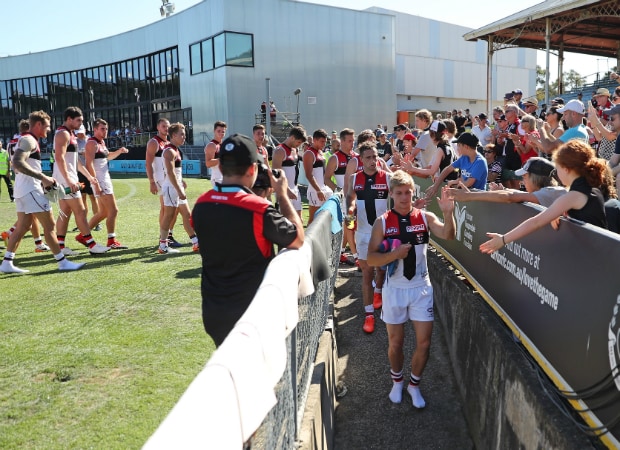An AFL interchange bench can look like a cluttered mess at times with a bunch of people operating in a tiny space. But just like a Formula 1 pit stop, everyone has a designated role to ensure the organised chaos functions as smoothly as possible. At a time where GPS monitors measure every movement, high performance staff keep their athletes finely tuned and coaches feed instant feedback and analysis from the box to the bench, this area is a constant hive of activity.
At Ikon Park, I tucked myself into the far right hand corner of the bench to observe the operation close up. With Alan Richardson parked at the other end of the back row, and with the players in front of him, I sat amongst the high performance and medical teams who resolved problems on the run. Beside us sat the runner and two other coaches who ran the rotations and roles from ground level. While it was only a practice match under the summer sun, it was a close-up look at how players are managed on game day.
1st Quarter
3:20 into the opening quarter Jack Steven crosses the line for his first spell of the afternoon. Before you know it, a procession follows as the interchange bench leaps to life early in the first quarter at Ikon Park. With the mercury nearing 30 degrees, the signs were there early that the Saints were going to use plenty of rotations.
New recruit Jack Steele stands on the boundary line awaiting a return to the action early in the first quarter. A piece of tape sits behind his left ear a little bigger than a band aid. Beneath the tape sits a concussion sensor that more than half of the players are wearing as part of a study being conducted by the AFL to measure head movement during collisions.
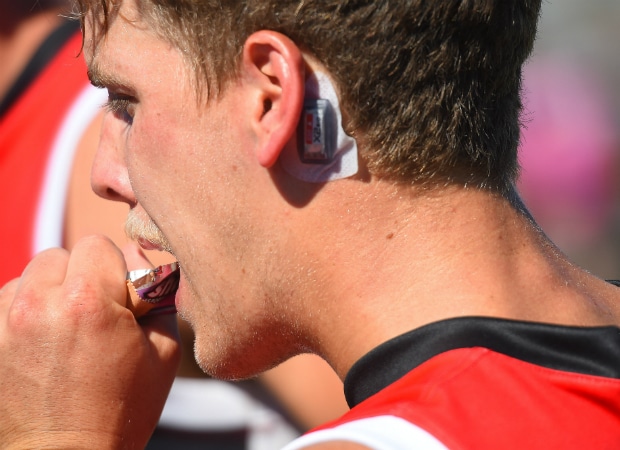
Small forward Jack Lonie wears a concussion sensor against the Blues.
With Assistant Coach Aaron Hamill overseeing proceedings against the Blues, Richardson watches on from the back of the bench. From ground level, the Senior Coach has immediate face-to-face access with the eight players sitting on the interchange bench at any one time.
After Charlie Curnow kicks Carlton’s second goal in quick succession, Richardson gives the players on the bench some stern feedback. Minutes later, Darren Minchington puts the Saints back in front before two goals from Josh Bruce gives St Kilda the ascendancy by the first change.
Midway through the opening term, Bailey Rice retreats to the bench cradling his hand. In his first moments in red, white and black, the father-son recruit dislocated his finger in a marking contest. St Kilda Doctor Ian Stone manipulates it back into place before Head Physiotherapist Andrew Wallis straps it up and the 20-year-old is ready to go again.
As Steven trots off the ground late in the first quarter for the fourth time already, two trainers spring to their feet and get to work his hamstrings. As the game wears on, more and more players receive ‘flush’ rubs when they come for a spell. Trainers work up and down tiring muscles, looking to recharge players for another set. Not every player opts for a rub, but some feel it helps them recover before returning to the action.
Behind the numbers: JLT Community Series
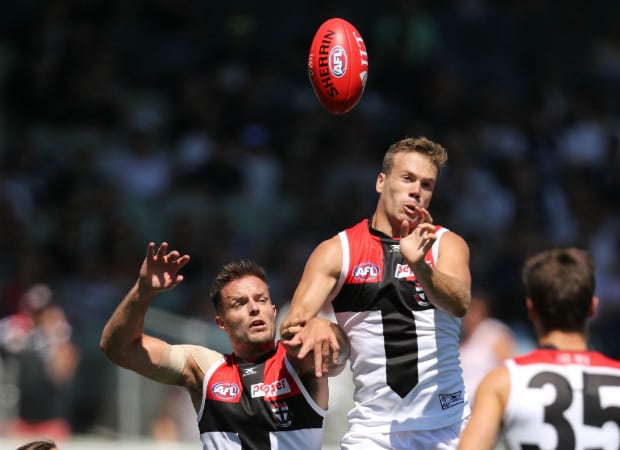
First-gamer Bailey Rice in the marking contest where he dislocated his finger.
2nd Quarter
As the second quarter gets underway in searing heat, players start drinking from a bottle labelled ‘pickle’. Inside this worn out bottle is pickle juice. St Kilda Nutritionist, Alison Miles, tells me later that athletes have been drinking pickle juice for years to help reduce the effects of cramps.
“Research has shown the brine from a jar of pickles prevents and relieves muscle cramps during vigorous activity. The vinegar in the liquid stimulates the receptors in the mouth, oesophagus and stomach, allowing the receptors in the muscles fibres to relax when a cramp is occurring,” Miles says.
On a day where he was one of the most influential players on the ground, Jack Billings makes a rare mistake in the centre square. The Blues run the ball forward but before you know it the highly rated wingman has run deep into defence and chased down Charlie Curnow, pinning him holding the ball. The bench erupts with Richardson using the live case study as an opportunity to teach the players sitting in front of him.
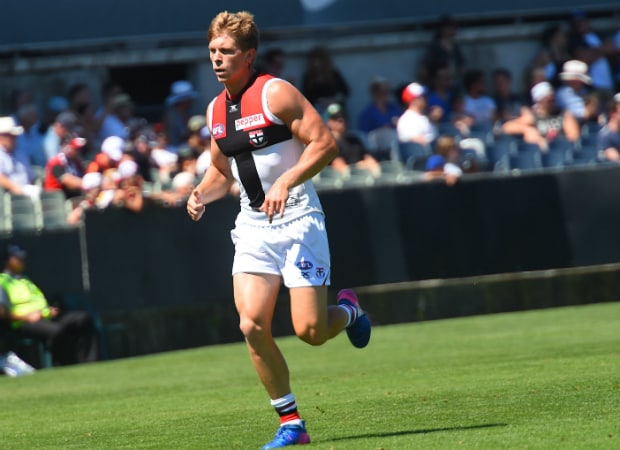
Acting captain Seb Ross runs off Ikon Park.
As the seconds wind down in the first half, stand-in-captain Seb Ross moves to the back row of the bench and asks: ‘What’s our pressure at ‘Macca’?’ Simon McPhee, one of the Saints’ assistant coaches, is parked in the back row with a headset on and a laptop in front of him. Champion Data stats bounce up and down the screen. Ross wants to know what the Saints’ pressure factor is at for the game.
Pressure factor is defined as pressure points per pressure chance. It is a little bit technical, but essentially it is a combination of physical pressure acts (when a player is in the act of disposing or when affecting a tackle that prevents effective disposal) and implied pressure acts (reducing an opponent’s decision making without making physical contact).
Champion Data have ten staff members at every game they cover and two of these people are dedicated solely to recording information on pressure. It’s not hard to see why given how important pressure is in the modern game. By the final siren, St Kilda registered an elite pressure factor 1.907. To put that number into context, the Saints recorded a number higher than that on only six occasions last year.
The JLT Community Series Wash-Up
3rd Quarter
In a manner avid Saints supporters have become accustomed to in recent years, Luke Dunstan goes back with the flight after the main break and gets poleaxed by Lachie Plowman, earning a free kick for his courage. The bench explodes as Dunstan slowly gets to his feet. He hands it off and heads to the bench to get some oxygen back into his lungs. It may only be a practice match, but the inside midfielder only knows one way. As soon as he sits down Richardson moves across to pat him on the back.
As new Saint Ben Long takes his first steps at AFL level, he sits on the bench next to Strength and Conditioning Manager Josh Low, whose role on game day extends to managing the rotations and roles from the bench. Looking at a screen in front of them, Low explains to the first-gamer what is expected of him in the role at that exact moment. Things change in games and here is a prime example of direction in motion. Before you know it, Long is off and running, preying on opposition defenders like his life depends on it.
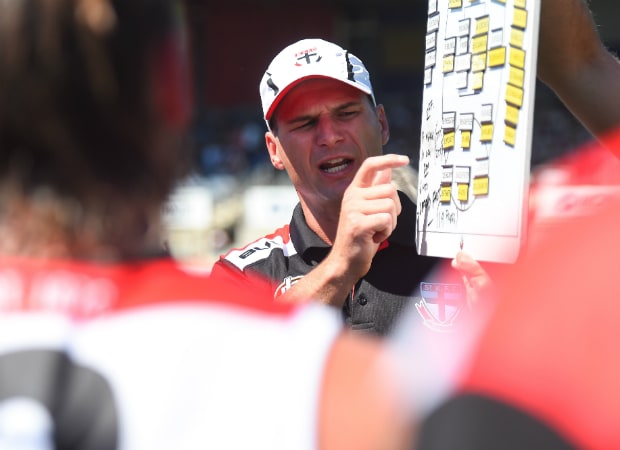
Acting coach Aaron Hamill works the magnet board ahead of the final quarter.
4th Quarter
There mightn’t be any premiership points on the line or any percentage benefit from putting their foot on the pedal, but St Kilda continue to be relentless in the last quarter. With many players desperate to put their cases forward for a Round 1 berth, it’s not surprising. One of those players to finish with a head full of steam is Long, who completes an eye-catching half by hunting down big-bodied Blues defender Simon White. The teenager pins him holding the ball and forces him off the ground after a big tackle. Then, to add insult to injury, Long splits the middle and his teammates come from everywhere.
On the bench, players and coaches look at each other with childish grins. A bemused Ross asks: “How many tackles has ‘Longy’ had?” As the numbers attest, the impact is noticeable, especially by someone in their first appearance at the level. By the final siren, the Saints first pick (No. 25) in last November’s National Draft has laid seven tackles in 42 per cent game-time. He also amasses 34.4 pressure points – the fourth most of any Saint. Talk about an eye-catching start by the Northern Territorian.
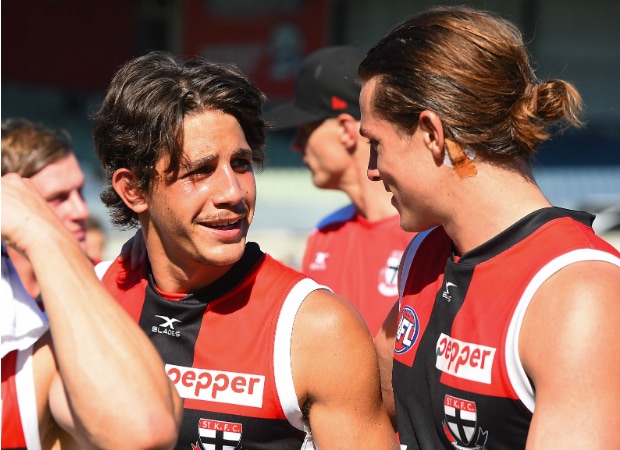
Tackling machine Ben Long after his first appearance in red, white and black.
The final siren sounds not long after that and the sports science and analytics staff begin packing up their temporary workspace for the afternoon. One item that sticks out more than anything else is a GPS receiver that looks like an oversized telescope and sits on the grass next to the bench monitoring the players’ every step. Inside the neckline at the back of every guernsey sits a tiny pouch that houses the Catapult GPS devices.
“The receiver sits on the boundary and feeds back all the data to the computer screens and that is just to keep an eye on where guys are at during each quarter, particularly the players we are managing in terms of workloads. We look at each individual and that all gets fed into our workload analysis for each player and that helps us determine what we are going to do with the individual throughout the next week and for the following weekend.” St Kilda High Performance Manager Matt Hornsby.
Are you with us in 2017? Become a St Kilda member today!
